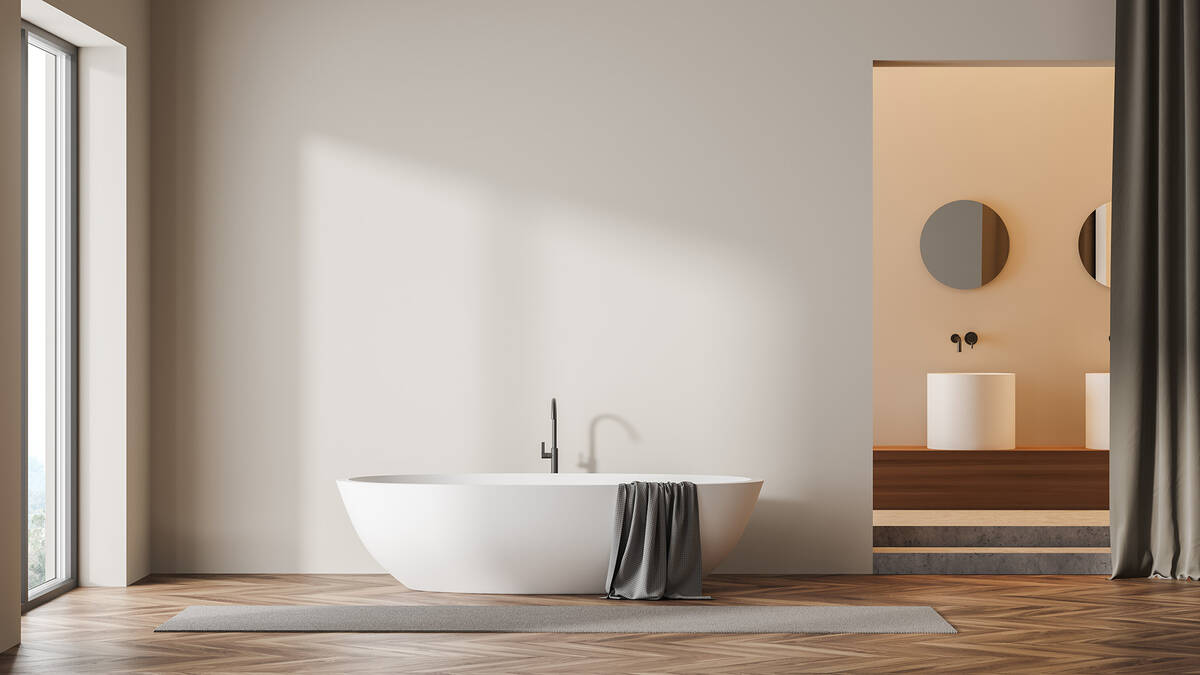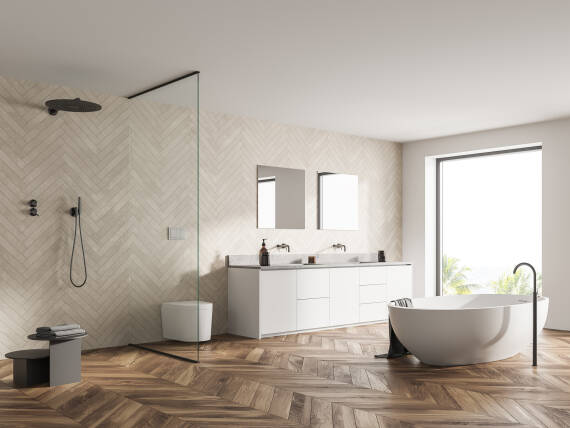Premium wooden flooring in the bathroom
Parquet in the bathroom: Premium, practical, and reliable
Untreated wood and moisture usually don’t get along. However, a parquet floor can visually enhance the bathroom while also offering many advantages. What do you need to know before you decide on premium parquet as a floor covering in the bathroom? Get comprehensive information here – including practical tips.

Is parquet really suitable for the bathroom?

Wood is a natural material. When it comes into contact with moisture, it soaks it up and swells. If the humidity decreases, the water evaporates and the natural product warps.
The critical value is 70 percent humidity. However, this limit shouldn’t be exceeded in any room, as a higher percentage usually leads to mold growth.
Thanks to surface finishing, nowadays it’s no problem to use these premium materials in damp spaces. However, it requires a little more care than tiles. With the right know-how, however, a wooden floor can be just as durable as other high-quality building materials.
Wooden flooring offers numerous advantages:
- Visually, the natural grain creates a unique mood, the ‘feel-good factor.’ It feels pleasantly warm underfoot – no comparison to cool tiles or natural stone.
- Wood contains tannic acids, which have an antibacterial effect. It's not as easy for a biofilm to develop here.
- The fine-pored material can store heat and has excellent insulating properties.
- Wood is a sustainable material because it is a renewable resource. However, it’s worth taking a closer look at its origins before making a purchase decision. This way, you can avoid environmental pollution caused by long transport routes.
Important information and tips for wooden flooring
Not every type of wood is suitable for damp rooms. For example, beech is one of the varieties that absorb moisture very easily, and is therefore not well suited.
The following woods are ideal for your bathroom
- Oak: This German natural product is particularly robust and durable.
- Walnut: This species expands very little, making it ideal for underfloor heating.
- Douglas fir: The North American spruce convinces with a pleasant feel and is easy to care for.
- Merbau: This tropical wood is particularly hard and resilient.
- Teak: This Asian variety stands up to moisture well and is resistant to mold.
Solid parquet made of individual boards is relatively resistant to moisture, as it doesn’t swell quickly at the edges. The multiple layers provide air moisture more surface for attack, so this flooring requires careful maintenance in the bathroom.
When laying the floor, we advise gluing the entire surface. The substructure with shear-resistant bonding consists of several layers that require craftsmanship and skill. It’s important to perfectly seal the subfloor with a permanently elastic joint.
Lacquered flooring requires little maintenance in a normal room. However, if some water is left standing on the sealant, for example after showering, the lacquer layer can crack. In the bathroom, oil is the perfect surface finish. Before using it for the first time, the
floor is treated several times with hard oil or hard wax oil. A polishing machine will carefully massage it in. This way, you can achieve an waterproofed surface that doesn’t easily absorb moisture. Hard oil soaks deep into the structure and protects it from the inside. Hard wax oil leaves a glossy protective film on the surface. Regardless of whether you use hard oil or hard wax oil, you should re-oil parquet flooring once a year either way.
If you have underfloor heating in your bathroom, you should choose parquet with low thickness. At 22 mm, enough heat can seep into the room. It’s best to ask a professional whether your selected floor is suitable for this type of heating.
How to properly care for your wood floors
With the right care and maintenance, wood proves to be a material that can last for decades in damp rooms. Worth keeping in mind when showering and bathing:
- Wipe up small puddles immediately. Long-standing water can penetrate even an oiled parquet.
- Pay attention to the humidity, with the help of a thermo-hygrometer, for example. You can reduce humidity levels with regular ventilation.
- The natural material always expands and contracts, even if it’s a dimensionally stable species. If small gaps appear, you should have them sealed immediately. Fillers made of neoprene are available for easy injection.
Frequently asked questions about parquet in the bathroom
The humidity should not exceed 70 percent.
The warm feel creates a homely atmosphere, unlike white tiles. It also has antibacterial properties, insulates well, and is less prone to mold.
Oak, walnut, red fir, merbau, and teak are suitable species for damp rooms.
Hard oil or hard wax oil are more suitable than sealing with varnish, as varnish can crack.
Yes, but it shouldn’t be thicker than 22 mm.
Bathroom and wooden floors: How the combination can work
Parquet is a premium floor covering that conveys a homey atmosphere. It’s also an antibacterial material with good insulating properties, which makes it suitable for underfloor heating. It is important that you choose the right type. Oiled, fully glued parquet can last for decades with just a little care, even in a damp room.
Trusted partners